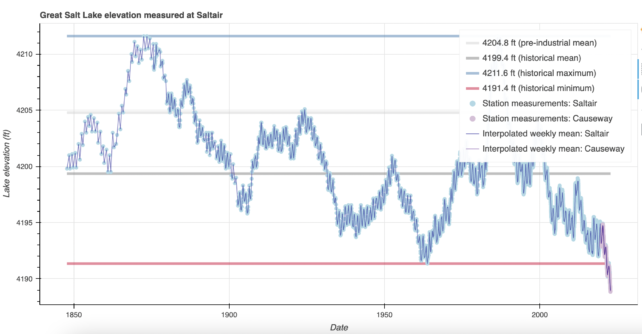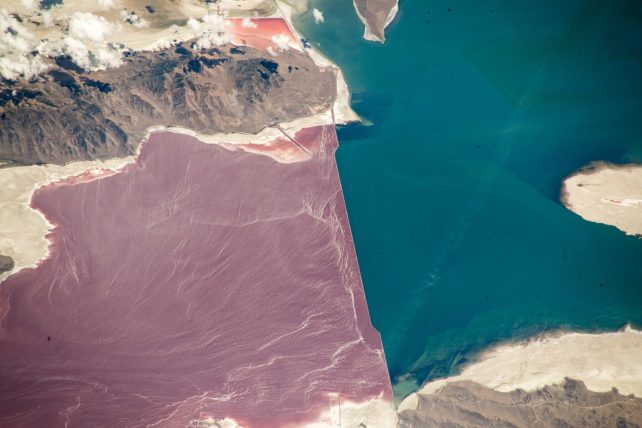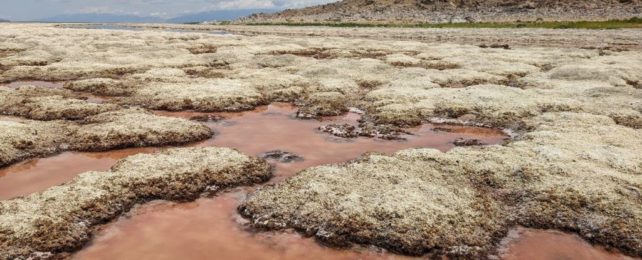Without urgent and major interventions, America's Great Salt Lake could experience ecosystem collapse in the next few years.
In a worst-case scenario, according to findings presented at the Geological Society of America's 2022 Connects Conference in Colorado this past weekend, the world-famous body of salt-water has just a few months before ecological recovery is significantly impeded by rising salinity levels.
Water from the rivers feeding into Utah's vast lake has been diverted for human consumption for more than a century. A 2017 study estimated that each year a total of 3.3 trillion liters of water is rerouted before reaching the lake, largely for drinking water and agriculture.
Since then, the state has slipped into a megadrought, further reducing the amount of fresh water entering the lake and setting a new record for the lowest water levels ever recorded.
Reports from earlier this year estimate the Great Salt Lake has shrunk by two-thirds since the 1980s, and the dramatic drop is exposing a precious ecosystem that people, industry, and animals all collectively depend on.
"This is not the type of record we like to break," Utah Department of Natural Resources Executive Director Joel Ferry said earlier this year.
"Urgent action is needed to help protect and preserve this critical resource. It's clear the lake is in trouble."

Utah's lake is one of very few places on Earth where mineralized underwater reefs known as microbialites still grow.
These structures might resemble rocks, but are actually dense concentrations of algae and bacteria. In fossil form, they are known as stromatolites and are considered the oldest evidence of life on Earth.
As water levels in the Great Salt Lake continue to drop, the modern versions of these 'living fossils' are rapidly drying out. As the underwater microbial mats meet the air, they turn from dark green to white. The bleached remains appear to recover only when returned to water of a suitable salinity.
The problem is, as the Great Salt Lake shrinks, it is becoming increasingly concentrated with salt. In 2022, researchers measured salinity levels as high as 26 percent in some spots; a vast difference to a more typical lake salinity of around 15 percent.
Under these extreme conditions, biologist Carie Frantz of Weber State University says microbial mat recovery is very weak and slow.
For several summers now, Frantz has led a team of undergraduate students to to monitor the lake's microbialites in the field and the lab to see what happens when bleached reefs are re-submerged.
"Last year, it was really encouraging, because we saw that they can come back, and they come back fast," she explains.
"This year we saw something very different, we don't see that clear increase we saw last year. The organisms are stressed at these salinity levels. It's possible it's just too high for them to grow."
The trend is very similar to what occurred in the northern part of the Great Salt Lake following the construction of a causeway in the 1950s. This lake-crossing railroad split the body of water into two parts.
Because the southern portion is the one mostly fed by fresh water, the northern section became dangerously salty and devoid of oxygen.
As salinity reached 25 percent, a mass die-off of photosynthetic microbes occurred in the lake, causing a pink hue that can be seen from space.

The Great Salt Lake is many times saltier than the ocean, and only some microbes can survive in these conditions. The ones that can make it are the foundations of the ecosystem, turning sunlight into nutrients for brine shrimp and brine flies, and eventually for the waterbirds that feed on them.
Dust and mercury pollution could be a problem in the future if the lake continues to dry out. When a lake in California met the same fate, local residents suffered far more from asthma and cardiovascular issues.
According to a recent report from The New York Times, the lake's bed also holds high levels of arsenic. If the shoreline continues to recede and expose the lakebed to the wind, it's possible that these poisons will be carried into the lungs of people living nearby.
Salt Lake City legislators have made some attempts to conserve water in the region, but researchers are worried these changes are not keeping pace with climate change or rising water demands.
Frantz and her team's findings are only hopeful if policymakers take drastic action.
"[If] the Great Salt Lake rebounds soon by some combination of societal shifts in water use and high precipitation years, the microbialite community may be able to recover," the team writes in their abstract.
Frantz, however, is concerned that won't happen. This is an emergency, she says, and as the body of water grows ever saltier, it's becoming harder for microbialites to recuperate.
"We're not acting as fast as the situation calls for," says Frantz in a recent GSA press release.
Bonnie Baxter, a biology professor at Westminster College, shares the concern. She told The New York Times in June that the Great Salt Lake ecosystem is on the precipice of collapse.
"It's terrifying."
